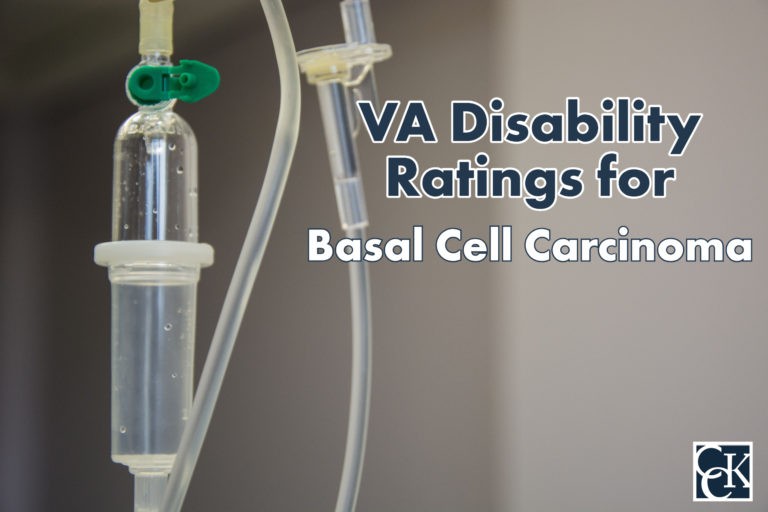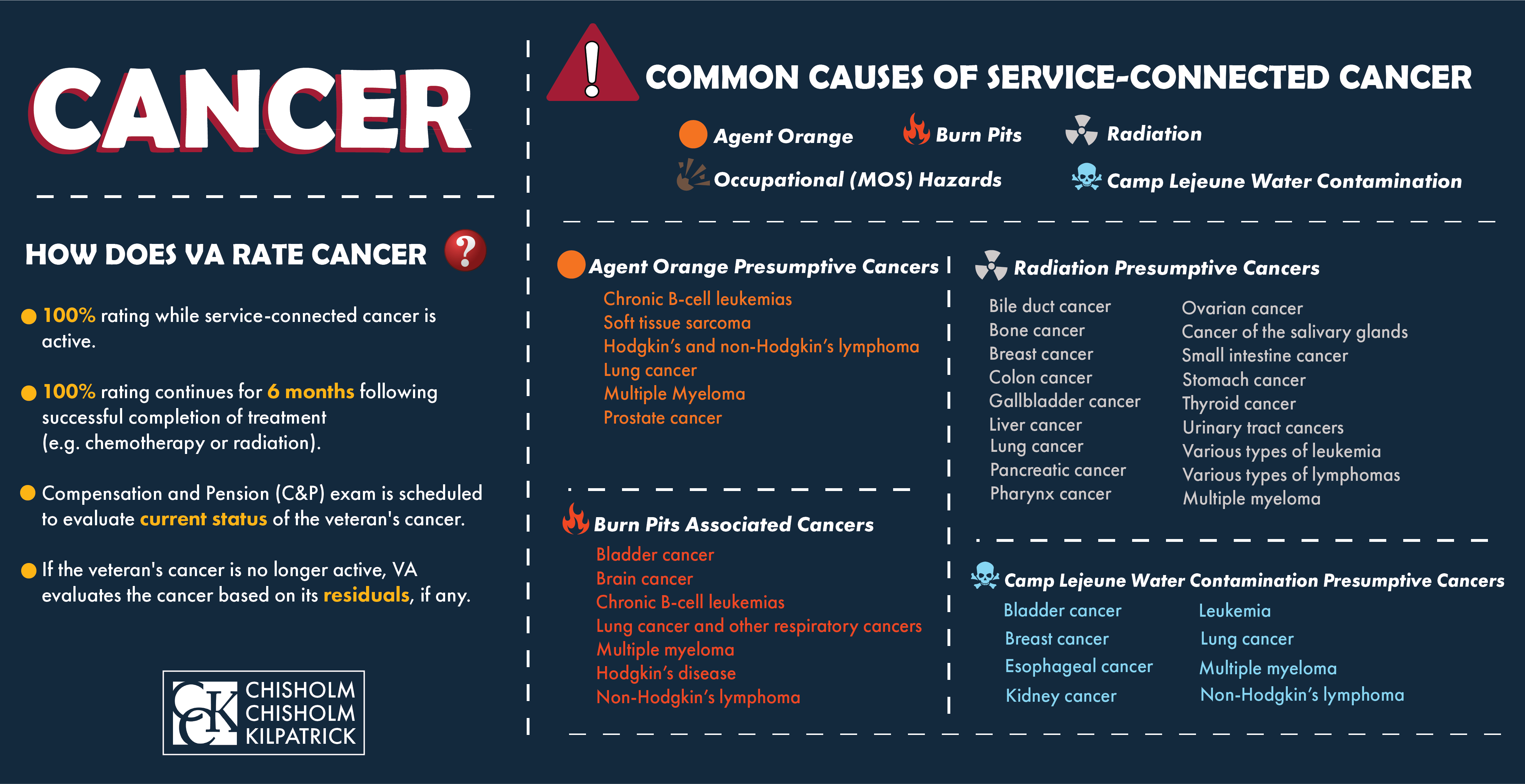VA Disability Ratings for Basal Cell Carcinoma

CCK Law: Our Vital Role in Veterans Law
What is Basal Cell Carcinoma?
Basal Cell Carcinoma is the most common form of skin cancer. In the United States, there are roughly 3.6 million cases of basal cell carcinoma each year. Specifically, this form of skin cancer is the result of the “abnormal, uncontrolled growth of basal cells.” Basal cell carcinoma does grow slowly, meaning that it is most often curable when it is caught early.
Basal cells are one of the three types of cells which exist in the top layer of skin. As new basal cells are formed, the old ones shed. When the DNA of these cells is damaged by exposure to ultraviolet (UV) radiation, the basal cells in the outermost layer of skin can begin to grow uncontrollably. UV radiation can come from the sun or even indoor tanning.
Often, basal cell carcinoma can appear as red sores, bumps, elevated growths, or scars. The condition may also “ooze, crust, itch, or bleed.” Typically, basal cell carcinoma appears on areas of the skin which have been exposed to the sun. If left untreated, basal cell carcinoma can become particularly invasive and destroy skin, tissue, and bone. In rare cases, the condition can be life-threatening.
Diagnosing and Treating Basal Cell Carcinoma
To diagnose basal cell carcinoma, a doctor may perform a physical exam and inquire about a person’s medical history. When diagnosing this skin condition, a person may also be referred to a dermatologist, a doctor who specializes in identifying and treating skin diseases.
Ultimately, a skin biopsy may be needed to determine if an area of the skin has cancer. The biopsy may remove the entirety of the tumor, which could treat the basal cell carcinoma. The sample taken in the skin biopsy is typically analyzed to determine if cancer is present.
There are various forms of treatment which may be used to remove basal cell carcinoma. The method of treatment used can be dependent upon a person’s age and general health, as well as how big the tumor is and where it is located.
Some forms of treatment which may be used include surgery, radiation therapy, and chemotherapy. Cryotherapy may be used for some small tumors while immunotherapy can be used for more advanced basal cell cancers.
Service Connection for Basal Cell Carcinoma
When filing a claim for service connection for basal cell carcinoma, the veteran will need to demonstrate a connection between their military service and their basal cell carcinoma. The veteran will also need to submit a diagnosis of their condition. In total, the veteran will need to submit the following to VA:
- A diagnosis of basal cell carcinoma;
- An in-service event, illness, or injury; and
- A nexus linking the veteran’s in-service occurrence with their basal cell carcinoma
In the instance of presumptive service connection, the veteran will not necessarily need a nexus linking the veteran’s in-service occurrence with their basal cell carcinoma.
To support the veteran’s claim for service connection, the veteran may submit lay evidence. Lay evidence, or lay statements, can be written by the veteran or anyone who knows the veteran and can speak to their condition. Importantly, lay evidence may also be submitted by fellow service members.

Compensation and Pension (C&P) Exams for Basal Cell Carcinoma
Once a claim has been filed for basal cell carcinoma, VA may request a Compensation and Pension exam, or C&P exam. To do this, VA may call the veteran or send a letter. It is very important to make sure VA has the veteran’s up-to-date contact information so that the veteran does not miss any C&P exam requests. It is also very important to attend the exam, as failure to attend can result in a denial of the veteran’s claim.
The exam will usually be performed by a VA physician or a VA contracted physician. Before the exam, the examiner will review the veteran’s c-file. This will contain any documentation that has previously been submitted to VA, as well as the veteran’s medical and service records. During the exam, the examiner may physically exam the veteran, particularly the areas of the skin which may be affected by basal cell carcinoma.
The veteran may also use a DBQ, or Disability Benefits Questionnaire, to bolster their claim. A Disability Benefits Questionnaire is a form created by VA for veterans to use to address important aspects of their condition, such as symptoms, severity, possible causes, and relation to other disabilities. The veteran may also have their private doctor fill out a DBQ for them. In claims for basal cell carcinoma, a dermatologist who treats the veteran for their condition may be able to provide more detailed insight into the veteran’s cancer.
VA Ratings for Basal Cell Carcinoma
For skin conditions, VA uses 38 CFR § 4.118, Diagnostic Codes 7800-7833 to issue ratings. For some conditions, ratings are given based upon how much skin is affected.
The General Rating Formula for the Skin, included in 38 CFR § 4.118, is used to rate the majority of skin conditions:
- “60% – at least one of the following: characteristic lesions involving more than 40% of the entire body or more than 40% of exposed areas affected; or constant or near-constant systemic therapy including, but not limited to, corticosteroids, phototherapy, retinoids, biologics, photochemotherapy, psoralen with long-wave ultraviolet-A light (PUVA), or other immunosuppressive drugs required over the past 12-month period
- 30% –at least one of the following: characteristic lesions involving 20-40% of the entire body, or 20-40% of exposed areas affected; or systemic therapy including, but not limited to, corticosteroids, phototherapy, retinoids, biologics, photochemotherapy, PUVA, or other immunosuppressive drugs required for a total duration of 6 weeks or more, but not constantly, over the past 12-month period
- 10% –at least one of the following: characteristic lesions involving at least 5%, but less than 20%, of the entire body affected, or at least 5% but less than 20%, of exposed areas affected, or intermittent systemic therapy including, but not limited to, corticosteroids, phototherapy, retinoids, biologics, photochemotherapy, PUVA, or other immunosuppressive drugs required for a total duration of less than 6 weeks over the past 12-month period
- 0% – no more than topical therapy required over the past 12-month period and at least one of the following: characteristic lesions involving less than 5% of the entire body affected; or characteristic lesions involving less than 5% of exposed areas affected; or rate as disfigurement of the head, face, or neck (DC 7800) or scars (DCs 7801, 7802, 7804, or 7805), depending upon the predominant disability”
Here, VA defines systemic therapy as any treatment that is injected, or taken by mouth, through the nose, or anally. This includes, but is not limited to, the treatments listed within the rating criteria. VA defines topical therapy as any treatment applied directly to the skin, regardless of the type of drug.
Exposure and Basal Cell Carcinoma
Veterans who have been exposed to military burn pits during their service may have gone on to develop basal cell carcinoma as a result.
What are Military Burn Pits?
Military burn pits are large areas of land where the military and its contractors incinerated waste. Following 9/11, the United States military used burn pits as part of its waste disposal protocol in places such as Iraq and Afghanistan. The practice was effective in reducing large quantities of waste, but the pits emitted plumes of toxic smoke. The following materials have been linked to military burn pits:
- Human waste
- Medical waste
- Ammunition
- Paint
- Plastic
- Rubber
- Styrofoam
- Other toxic chemicals
- Spoiled food
- Lubricants
- Petroleum
Is there Presumptive Service Connection for Military Burn Pit Exposure?
At this time, there is little conclusive research on the long-term health impacts of burn pits. One of the toxins released by burn pits is called TCDD, one of the major toxins in Agent Orange.
VA has not established a presumption for veterans exposed to burn pits like it has for veterans exposed to Agent Orange. Since there is no presumption, VA adjudicates burn pit claims on a case-by-case basis.
VA does not have a consistent approach to deciding these claims, so lay evidence from veterans is key to winning burn pit claims. Often, VA does not have a way of proving veterans were near burn pits, so statements from the veteran themselves or buddy statements can help prove exposure.
New Proposed Burn Pit Legislation 2021
As of 2021, there are several major bills currently pending in Congress that deal with the toxic exposure caused by burn pits. These bills include:
- Conceding Our Veterans’ Exposure Now and Necessitating Training Act (COVENANT)
- Presumptive Benefits for War Fighters Exposed to Burn Pits and Other Toxins Act of 2021
- Veterans Burn Pit Exposure Recognition Act
- Toxic Exposure in the American Military Act (TEAM)
Any of these bills, if passed, would offer needed relief to veterans suffering the toxic effects of burn pit exposure.
VA Individual Unemployability (TDIU) for Basal Cell Carcinoma
Veterans who are prevented from working because of their basal cell carcinoma, or symptoms of their basal cell carcinoma, may be able to receive a monthly VA disability benefit called total disability based on individual unemployability, or TDIU. This benefit compensates veterans at the 100 percent rating level, even if their disability rating may be less than that.
There are generally two pathways to become eligible for TDIU:
- 38 CFR § 4.16a (“Schedular”) – For this form of TDIU, the veteran must have:
- One condition rated at minimum 60 percent; OR
- two conditions that can be combined to reach 70 percent, where one condition is at minimum 40 percent
- 38 CFR § 4.16b (“Extraschedular”) – This form of TDIU is for veterans who may not be able to achieve the ratings necessary for schedular TDIU but are still unable to obtain substantially gainful employment on account of their conditions.
- In this instance, the veteran must prove that their condition is uniquely hinders their ability to obtain substantially gainful employment and therefore should not be rated on the standard disability rating criteria.
Veterans with multiple conditions may have a combined rating which would make them eligible for TDIU. As a result, veterans who receive a rating for their basal cell carcinoma may be able to receive compensation at the 100 percent rating level through TIDU.
Getting Help with Denied VA Claims Based on Basal Cell Carcinoma
Veterans who were exposed to military burn pits and developed basal cell carcinoma as a result of their service may feel frustrated that VA does not recognize the condition as presumptive. As such, an accredited representative or lawyer may be able to assist veterans who are trying to become service-connected.
The VA disability lawyers at Chisholm, Chisholm & Kilpatrick may be able to help with your appeal for disability benefits based on your basal cell carcinoma. For a free case evaluation, call our office at 800-544-9144.
About the Author
Share this Post


